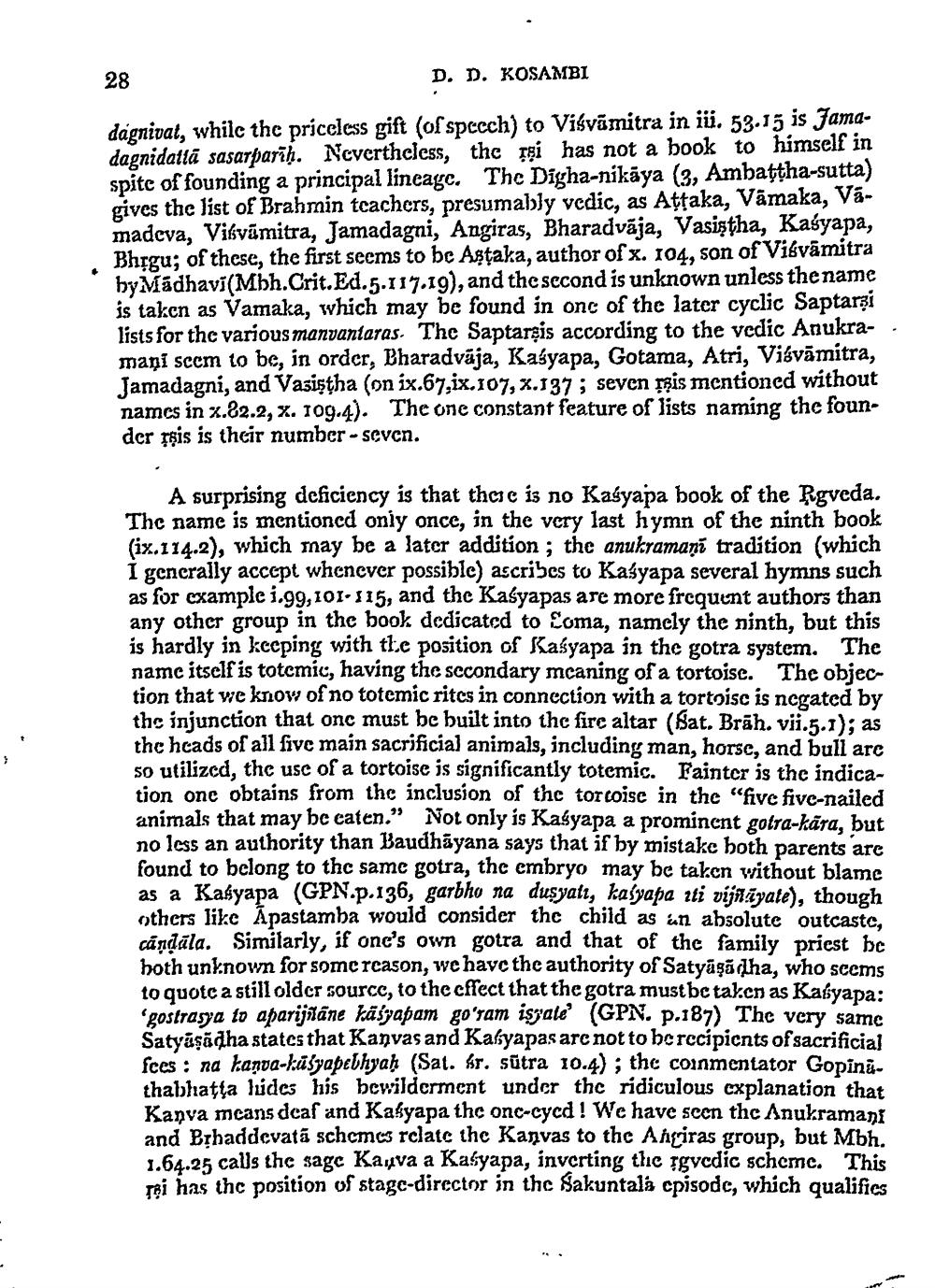Book Title: Origin of Brahmin Gotras Author(s): Dharmanand Kosambi Publisher: D D Kosambi View full book textPage 8
________________ 28 D. D. KOSAMBI dagnivat, while thc priceless gift (of speech) to Viśvāmitra in iü. 53.15 is Jamadagnidatlā sasarparīḥ. Nevertheless, thc îşi has not a book to himself in spite of founding a principal lincage. The Digha-nikāya (3, Ambattha-sutta) gives the list of Brahmin teachers, presumably vcdic, as Attaka, Vāmaka, Vámadeva, Vibyūmitra, Jamadagni, Angiras, Bharadvāja, Vasiştha, Kaśyapa, Bhrgu; of these, the first seems to be Astaka, author of x. 104, son of Vibvāmitra by Madhavi(Mbh.Crit.Ed.5.117.19), and the second is unknown unless the name is taken as Vamaka, which may be found in onc of the later cyclic Saptarsi lists for the various manvantaras. The Saptarzis according to the vcdic Anukra- . mani sccm to be, in order, Bharadvája, Kasyapa, Gotama, Atri, Viévāmitra, Jamadagni, and Vasiştha (on ix.67.ix.107,%.137 ; seycn rris mcntioned without namcs in x.82.2, X. 109.4). The one constant feature of lists naming the founder tsis is their number - scvcn. A surprising deficiency is that these is no Kasyapa book of the Rgveda. The name is mentioncd only once, in the very last hymn of the ninth book (ix.114.2), which may be a later addition ; the anukramanī tradition (which I gencrally accept whenever possiblc) ascribes to Kasyapa several hymns such as for example i.99, 101.515, and the Kaśyapas are more frequent authors than any other group in the book dedicated to Eoma, namely the ninth, but this is hardly in keeping with the position of Kaśyapa in the gotra system. The name itself is totemic, having the secondary mcaning of a tortoise. The objection that we know of no totemic rites in connection with a tortoisc is ncgated by the injunction that onc must be built into thc fire altar (Sat. Brāh. vii.5.1); as the heads of all five main sacrificial animals, including man, horsc, and bull arc 50 utilized, the use of a tortoise is significantly totemic. Fainter is the indication onc obtains from the inclusion of the tor coise in the "five fivc-nailed animals that may be eaten." Not only is Kaśyapa a prominent gotra-kära, but no less an authority than Baudhāyana says that if by mistake hoth parents are found to belong to thc samc gotra, the embryo may be taken without blame as a Kahyapa (GPN.p.136, garbho na duşyatt, kalyapa iti vijn.iyate), though others like Āpastamba would consider the child as an absolute outcaste. candāla. Similarly, if one's own gotra and that of the family priest be both unknown for some reason, we havc thc authority of Satyaşadha, who seems to quotc a still older source, to the effect that thegotra mustbc taken as Kabyapa: gostrasya to aparijñāne käsyapam go'ram isgale' (GPN. p.187) The very samo Satyaşadha states that Kanvas and Kabyapas arc not to bcrccipicnts of sacrificial fces : na kanda-kūbyapebhyah (Sat. sr. Sūtra 10.4); thc coinmentator Gopini. thabhatta ludes his bewildcrment under thc ridiculous explanation that Kanva mcans dcaf and Kasyapa thc onc-cycd ! We have seen thc Anukramani and BỊhaddevatā scheme rclatc thc Kanvas to the Anciras group, but Mbh. 1.64.25 calls the sage Kaqva a Kaśyapa, inverting the rgvcdic scheme. This rai has the position of stagc-director in the Sakuntala cpisode, which qualifics hoth uni Similarly, it would considen dusyalı, kasy be taken wit parents arePage Navigation
1 ... 6 7 8 9 10 11 12 13 14 15 16 17 18 19 20 21 22 23 24 25 26 27 28 29 30 31 32 33 34 35 36 37 38 39 40 41 42 43 44 45 46 47 48 49 50 51 52 53 54 55 56 57 58 59
